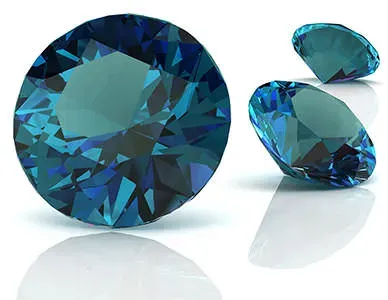 The name chrysoberyl comes from the Greek words chrysos, meaning golden, and beryllos, which refers to its beryllium content. Chrysoberyl has been a prized stone for thousands of years in Asia, as it is believed to provide the wearer with protection from the evil eye. There are three different gem varieties of chrysoberyl. Each of these stones is chemically alike, but optically very different, each one having a unique and beautiful feature of its own. The pale yellow green variety of chrysoberyl came from Brazil, and was known as chrysolite. It was popular in Spanish and Portugese jewelry in the 18th and 19th centuries. This stone displays an exceptional brilliance.
The name chrysoberyl comes from the Greek words chrysos, meaning golden, and beryllos, which refers to its beryllium content. Chrysoberyl has been a prized stone for thousands of years in Asia, as it is believed to provide the wearer with protection from the evil eye. There are three different gem varieties of chrysoberyl. Each of these stones is chemically alike, but optically very different, each one having a unique and beautiful feature of its own. The pale yellow green variety of chrysoberyl came from Brazil, and was known as chrysolite. It was popular in Spanish and Portugese jewelry in the 18th and 19th centuries. This stone displays an exceptional brilliance.
 Today however, the most popular varieties of chrysoberyl are cat's eye and alexandrite. Alexandrite, which is a very durable and rare stone, displays a beautiful color change. In the daylight, it is green, but under incandescent light, it changes to a red, mauve, or brown color. It has been said that alexandrite was named after czar Alexander II, as it was discovered on the czar's birthday in 1830, in the Ural Mountains. Cat's eye, which is also known as cymophane, contains many parallel, featherlike fluid inclusions or needle like inclusions of rutile. These inclusions, when cut as cabochons, display a white line across the yellowish gray stone. Chrysoberyl is a beryllium aluminum oxide. It is a very hard, durable stone, rating an 8.5 on the hardness scale. In fact, chrysoberyl is exceeded in hardness only by diamonds and corundum. Chrysoberyl has a vitreous luster and occurs in a wide range of colors, from green, to greenish yellow, yellow and brown. When cut well, gems are quite brilliant, but lack fire.
Today however, the most popular varieties of chrysoberyl are cat's eye and alexandrite. Alexandrite, which is a very durable and rare stone, displays a beautiful color change. In the daylight, it is green, but under incandescent light, it changes to a red, mauve, or brown color. It has been said that alexandrite was named after czar Alexander II, as it was discovered on the czar's birthday in 1830, in the Ural Mountains. Cat's eye, which is also known as cymophane, contains many parallel, featherlike fluid inclusions or needle like inclusions of rutile. These inclusions, when cut as cabochons, display a white line across the yellowish gray stone. Chrysoberyl is a beryllium aluminum oxide. It is a very hard, durable stone, rating an 8.5 on the hardness scale. In fact, chrysoberyl is exceeded in hardness only by diamonds and corundum. Chrysoberyl has a vitreous luster and occurs in a wide range of colors, from green, to greenish yellow, yellow and brown. When cut well, gems are quite brilliant, but lack fire.
 Alexandrite's color change is caused by small amounts of iron or chromium. Alexandrite is also strongly pleochroic, appearing green, red, orange or yellow when viewed from different directions. Cat's eye on the other hand, displays no pleochroism. The stone ranges in color from a honey yellow or honey brown color, to a yellowish green or almost
Alexandrite's color change is caused by small amounts of iron or chromium. Alexandrite is also strongly pleochroic, appearing green, red, orange or yellow when viewed from different directions. Cat's eye on the other hand, displays no pleochroism. The stone ranges in color from a honey yellow or honey brown color, to a yellowish green or almost ![]() emerald green. The most highly prized cat's eye color however, is a light golden brown. Cat's eye has a lovely velvety, silk like texture and is different than the common
emerald green. The most highly prized cat's eye color however, is a light golden brown. Cat's eye has a lovely velvety, silk like texture and is different than the common ![]() quartz variety of cat's eye, which is brown and called tiger's eye. Tiger's eye is much weaker in color than cat's eye.
quartz variety of cat's eye, which is brown and called tiger's eye. Tiger's eye is much weaker in color than cat's eye.
 Chrysoberyl is a very important stone for making important life decisions. It brings the wearer a great clarity, keenness of perception, and most importantly, strength. The stone has the ability to give the wearer a certainty in decision making, incomparable to the power of any other gemstone. Chrysoberyl is also a powerful healing stone on the physical level. Cat's eye has always been thought to protect from the evil eye, therefore bringing long life to the wearer. However, it was also once believed that one who dreamed of a cat's eye, was somehow involved with treachery. Cat's eye and alexandrite can be found in Sri Lanka, Brazil, China, Myanmar, Southern India, Zimbabwe, Tanzania, and Madagascar.
Chrysoberyl is a very important stone for making important life decisions. It brings the wearer a great clarity, keenness of perception, and most importantly, strength. The stone has the ability to give the wearer a certainty in decision making, incomparable to the power of any other gemstone. Chrysoberyl is also a powerful healing stone on the physical level. Cat's eye has always been thought to protect from the evil eye, therefore bringing long life to the wearer. However, it was also once believed that one who dreamed of a cat's eye, was somehow involved with treachery. Cat's eye and alexandrite can be found in Sri Lanka, Brazil, China, Myanmar, Southern India, Zimbabwe, Tanzania, and Madagascar.